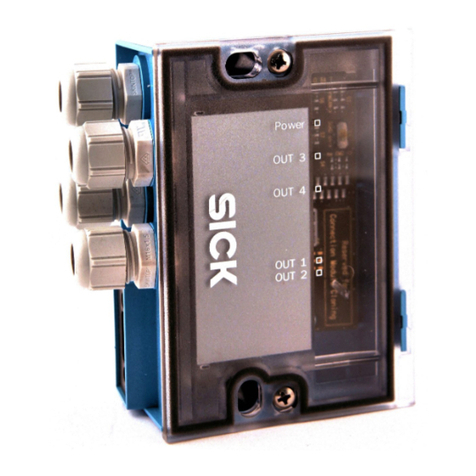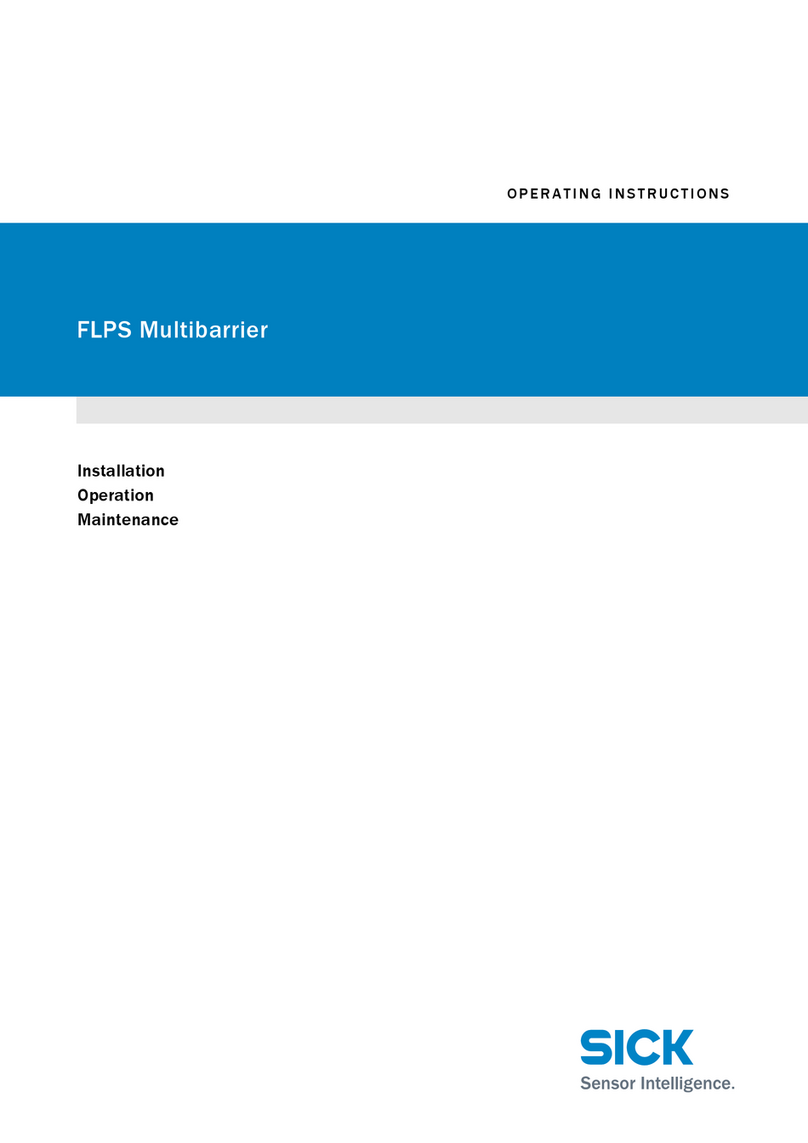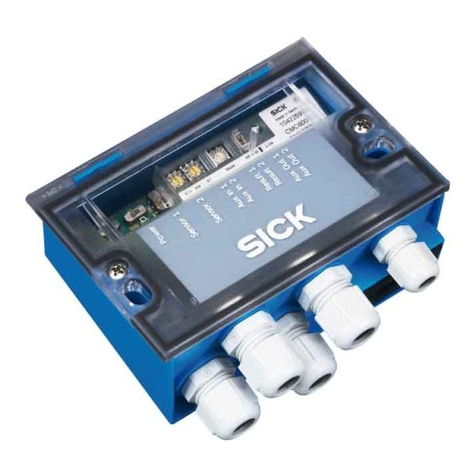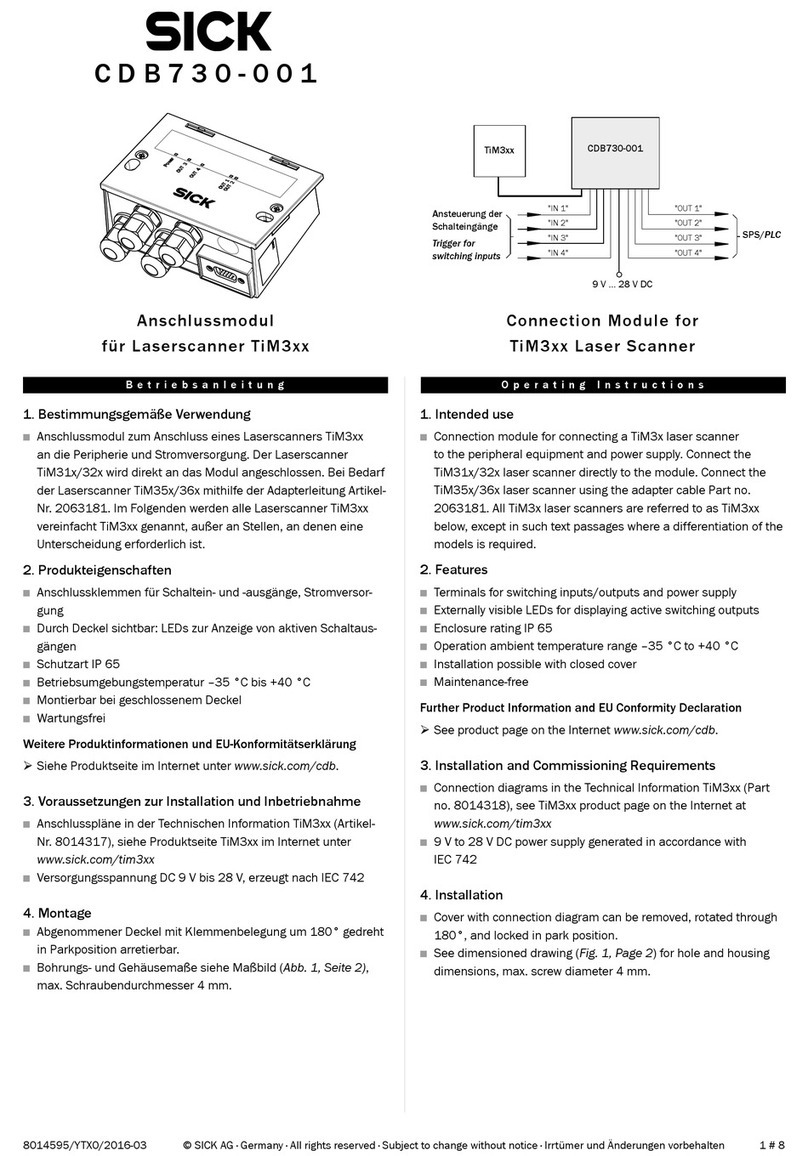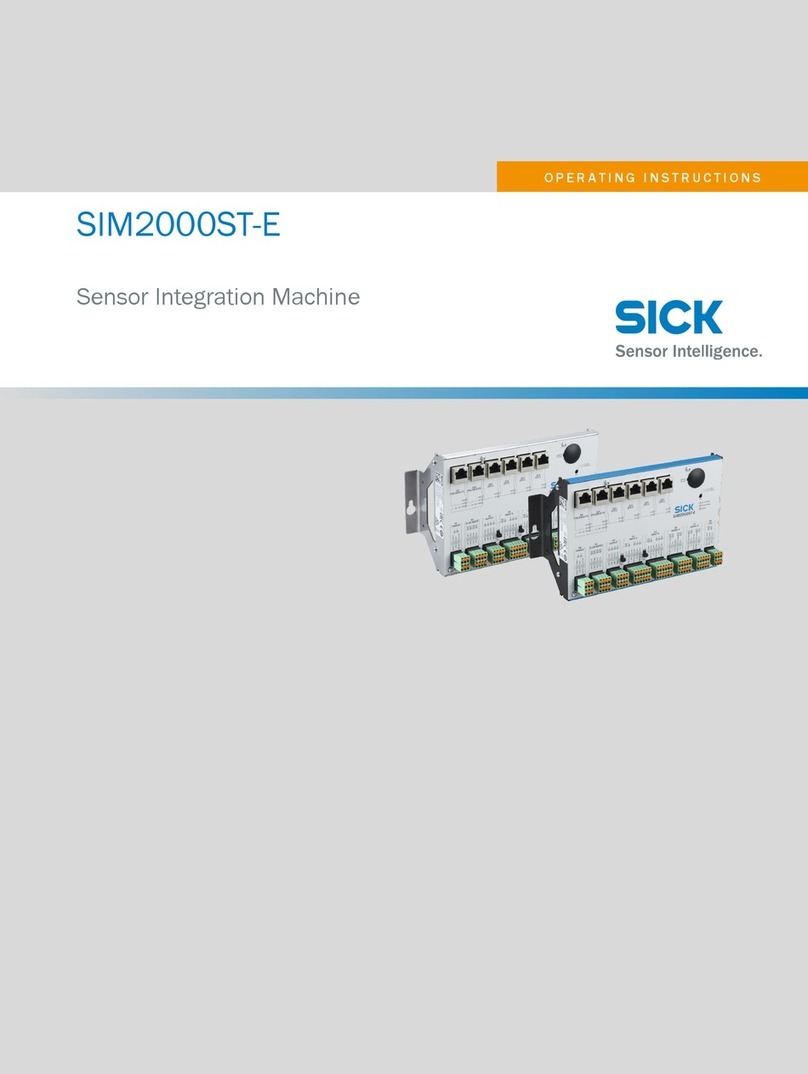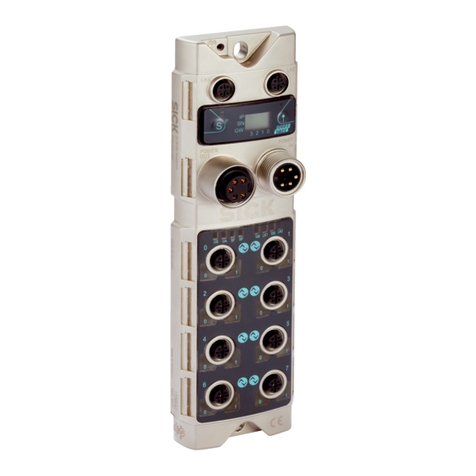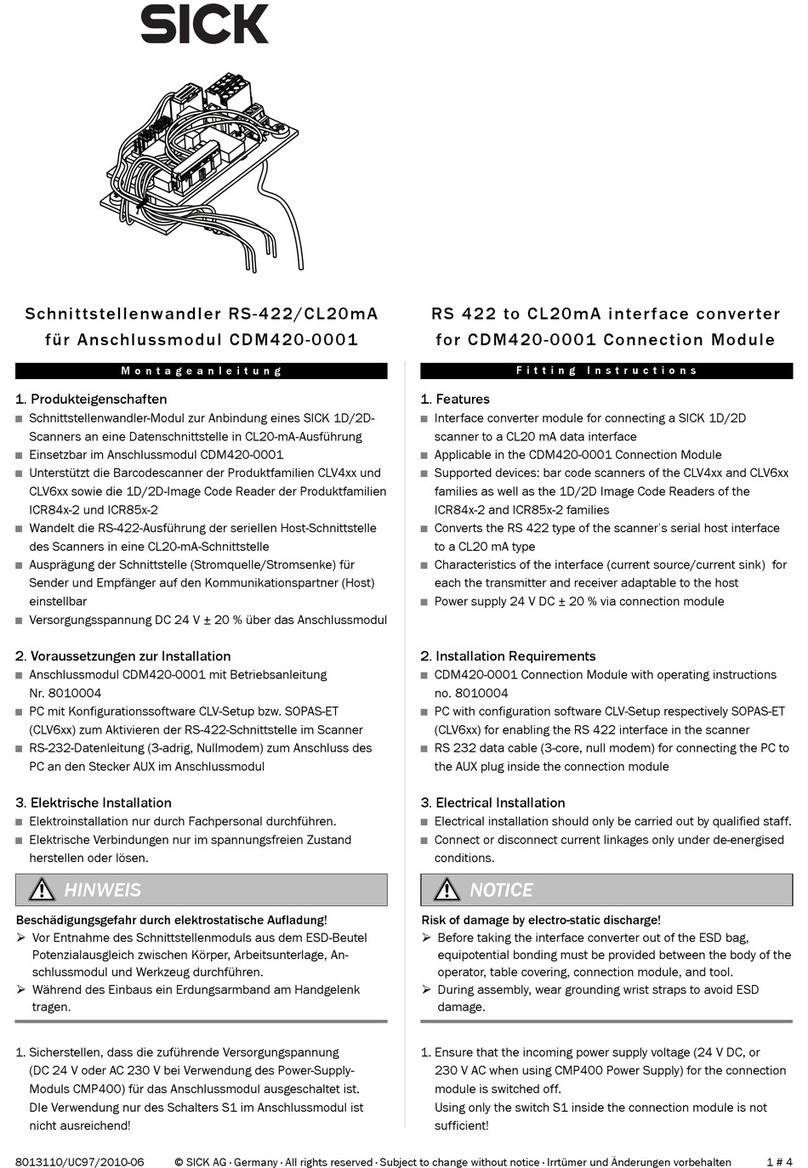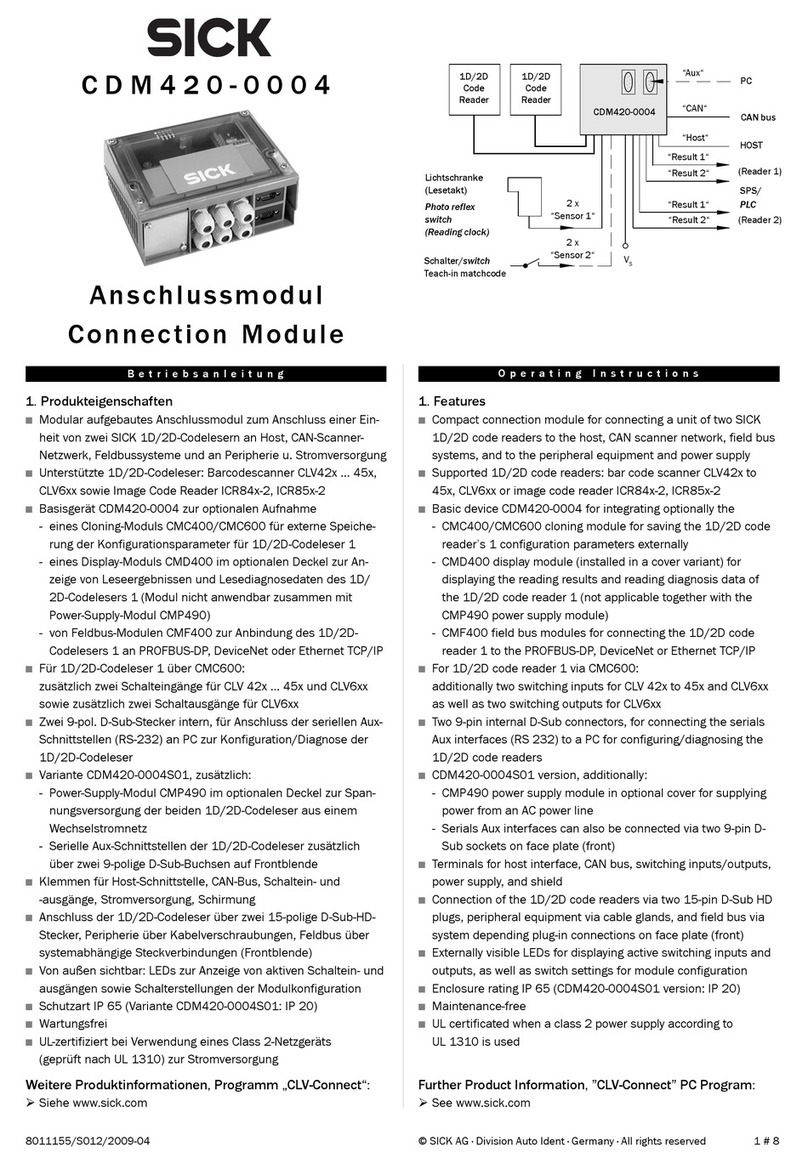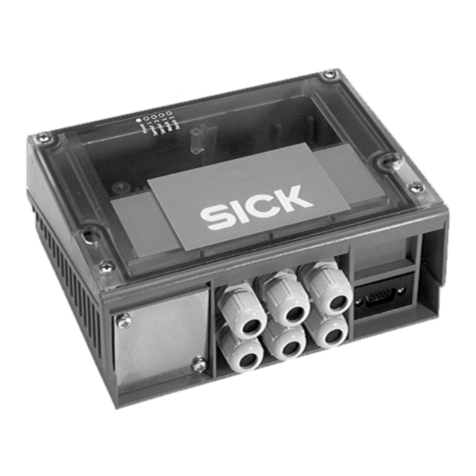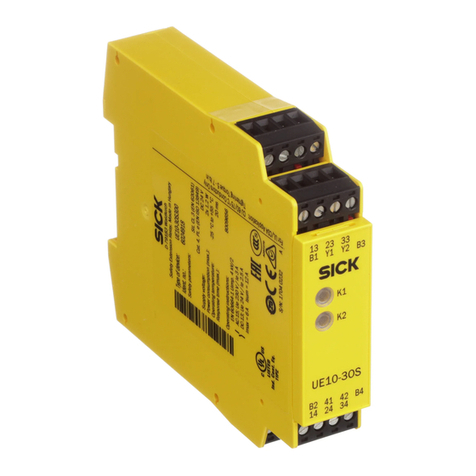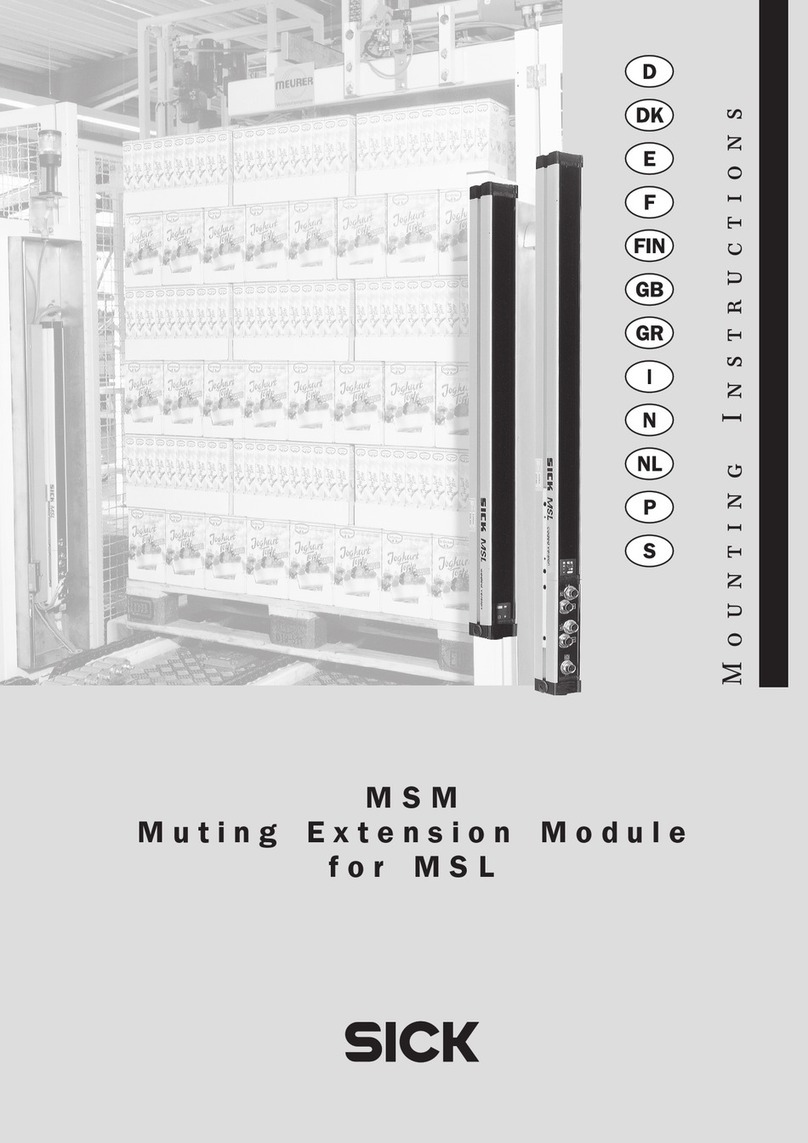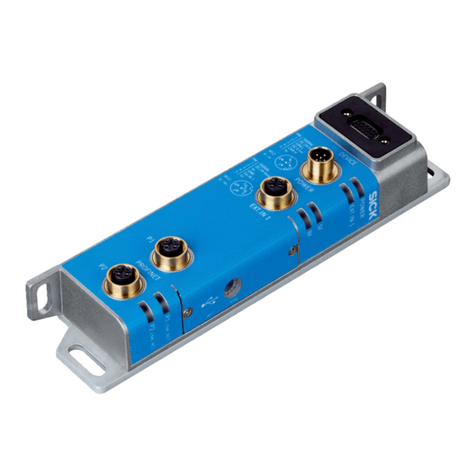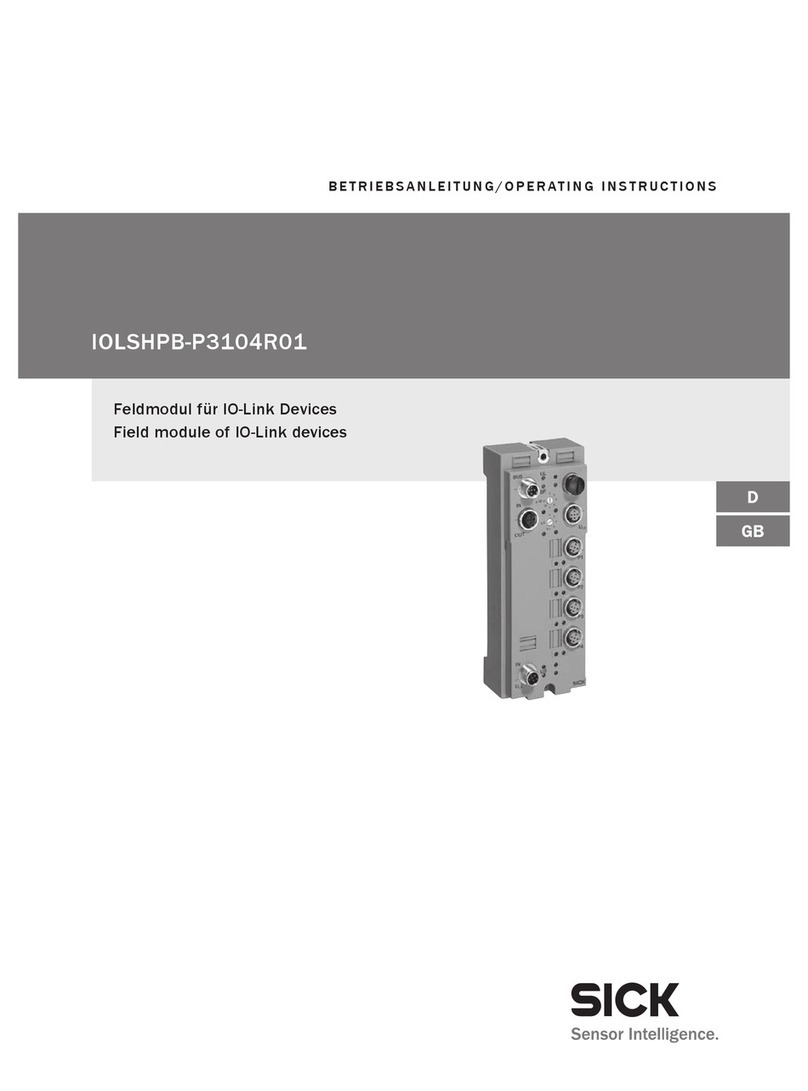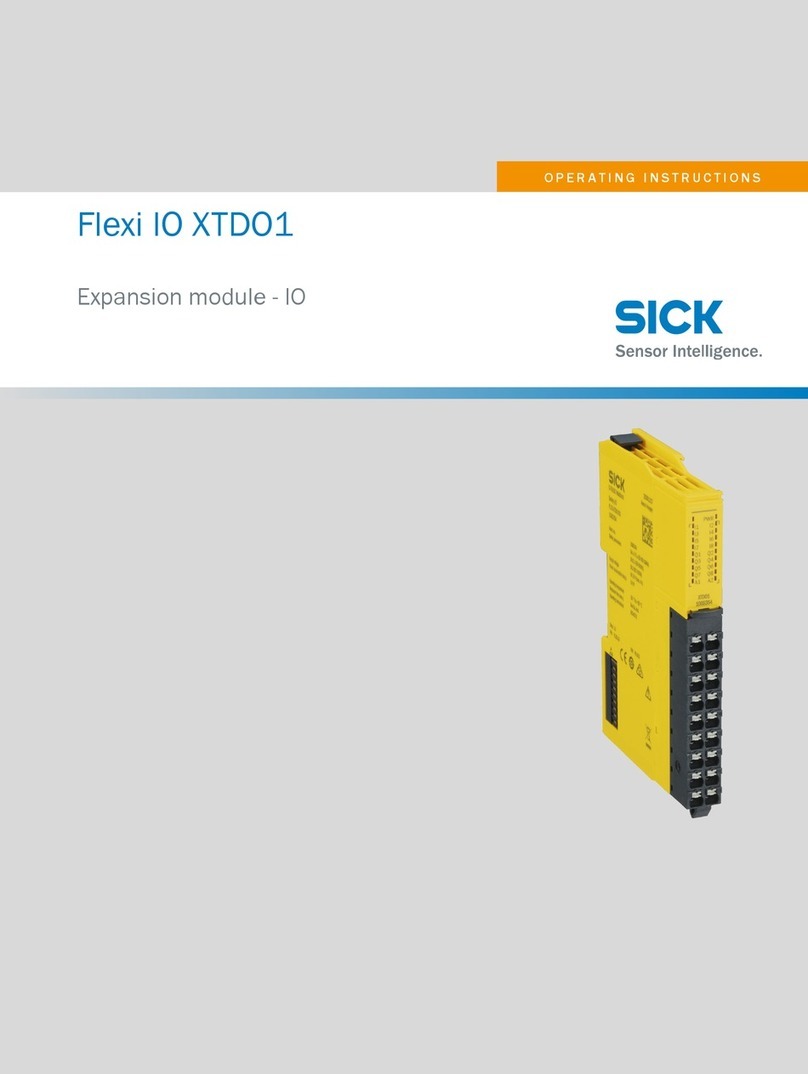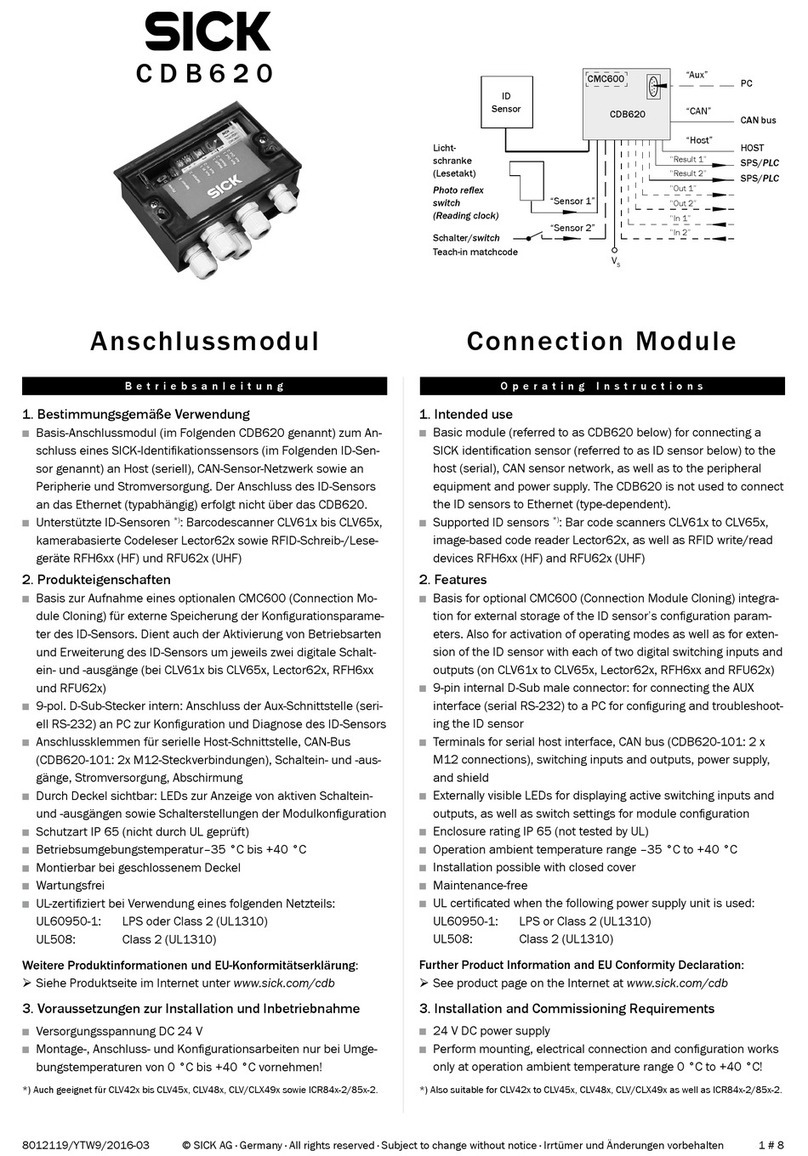
N O T I C E D ’I N S T R U C T I O N S
UE10-3OS
Module d’extension pour
modules principaux
fr
SICK AG • Industrial Safety Systems
ErwinSick-Straße 1
D-79183 Waldkirch • www.sick.com
8009656/YSS0/2016-03-17 • REIPA/XX
Printed in Germany (2016-03) • Tous droits réservés •
Sujet à modification sans préavis
1 Disponibilité des fonctions
Cette notice d’instructions concerne les modules
d’extension UE103OS pour modules principaux
comportant la mention suivante sur le champ
Operating Instructions de la plaque signalétique :
8009656
La date de fabrication du module est indiquée sur la
plaque signalétique dans le champ Date Code format
aassxxxx (aa = année, ss = n° de semaine, xxxx =
numéro de série).
Cette notice d’instructions est une traduction de la
notice d’instructions d’origine.
2 La sécurité
Ce chapitre est essentiel pour la sécurité tant des
installateurs que des opérateurs de l’installation.
Lire impérativement ce chapitre avec attention avant
de commencer à mettre en œuvre l’UE103OS ou la
machine protégée par l’UE103OS.
2.1 Personnel qualifié
Le module d’extension UE103OS ne doit être monté,
installé, mis en service et verifié que par un personnel
qualifié.
Sont qualifiées les personnes qui …
ont reçu la formation technique appropriée et
ont été formées par l’exploitant à l’utilisation de
l’équipement et aux directives de sécurité en vigueur
applicables et
ont accès à la notice d’instructions du module
d’extension UE103OS et l’ont lue et assimilée.
2.2 Domaine d’utilisation de l’appareil
Le module d’extension UE103OS peut être mis en
œuvre :
selon EN ISO 13 849 jusqu’au niveau de
performance PL e et la catégorie 4
selon EN 62 061 jusque SILCL3
selon CEI 61 508 jusque SIL3
Le «Performance Level» (niveau de performance)
effectivement atteint ou l’indice SIL limite atteint
dépendent du schéma externe, de la version du
câblage, du choix de l’organe de commande et de la
façon dont il est raccordé sur place à la machine.
Le module d’extension UE10-3OS a été testé selon la
norme UL 508.
Le module d’extension UE103OS est utilisé dans le cadre
de :
équipements de protection électrosensible (ESPE) avec
sorties TOR actives (OSSD) surveillées : monovoie, bivoie
(selon CEI 61 4961)
modules de sécurité à sorties statiques autocontrôlées,
par ex. Flexi Classic et Flexi Soft
L’UE103OS ne dispose pas du verrouillage de redémarra-
ge ni du contrôle des contacteurs commandés.
2.3 Conformité d’utilisation
Le rmodule d’extension UE103OS ne peut être utilisé que
dans les domaines décrits au paragraphe 2.2 «Domaine
d’utilisation de l’appareil».
Il ne peut en particulier être mis en œuvre que un personnel
qualifié et seulement sur la machine sur laquelle il a été
installé et mis en service initialement par une personne
qualifiée à cet effet selon les prescriptions de cette notice
d’instructions. Pour toute autre utilisation, aussi bien que
pour les modifications – y compris concernant le montage
et l’installation – la responsabilité de la société SICK AG ne
saurait être invoquée.
2.4 Consignes de sécurité et mesures de
protection d’ordre général
Respecter les consignes de sécurité et les
mesures de protection !
Pour garantir la conformité d’utilisation du module
d’extension UE103OS il faut observer les points
suivants.
Il faut s’assurer que le montage, l’installation et
l’utilisation du module d’extension sont confor-
mes aux normes et à la réglementation du pays
d’exploitation.
Pour le montage et l’exploitation du module
d’extension ainsi que pour son mise en service et
les tests réguliers il faut impérativement
appliquer les prescriptions légales nationales et
internationales et en particulier :
– la directive machine
– la directive d’utilisation des installations
– la directive CEM
– les prescriptions de prévention des accidents
et les règlements de sécurité
Le fabricant et l’exploitant de la machine à qui
est destiné le module d’extension sont responsa-
bles de l’application stricte de toutes les pre-
scriptions et règles de sécurité en vigueur.
Les tests doivent être exécutés par un personnel
qualifié et/ou des personnes spécialement auto-
risées/mandatées ; ils doivent être documentés
et cette documentation doit être disponible à
tout moment.
La notice d’instructions doit être mise à dispo-
sition de l’opérateur de la machine sur laquelle
l’UE103OS est mis en œuvre.
L’opérateur de la machine doit être formé par un
personnel qualifié et prendre connaissance de
cette notice d’instructions.
2.5 Pour le respect de l’environnement
L’élimination des appareils mis au rebut ou irréparables
doit toujours être effectuée dans le respect des prescrip-
tions concernant l’élimination des déchets (par ex. Code
européen des déchets 16 02 14).
3 Description du produit
Via les sorties TOR à contact du module d’extension, on
peut produire un arrêt de sécurité des actionneurs corres-
pondants de la machine ou de l’installation.
La commutation des sorties statiques à semi-conducteurs
du module principal câblé en commande des relais inter-
nes via deux circuits d’entrée séparés. Les contacts de
commande servent de sortie de sécurité. Le contact d’état
n’est pas une sortie de sécurité. Le contact de retour sert de
contrôle des contacteurs commandés pour la surveillance
via le module principal.
Pour atteindre le niveau SIL3/PL e, raccorder le
contrôle des contacteurs commandés !
Pour atteindre le niveau SIL3/PL e, il faut utiliser un
diagnostic externe avec DC T99% (c.-à-d. que le
contrôle des contacteurs commandés doit être
raccordé).
À cet effet, observer également les instructions du
chapitre 11 «Exemples d’applications».
Indicateurs
Indication Interprétation
K1 Vert Voie 1 commutée
K2 Vert Voie 2 commutée
4 Montage
Montage uniquement avec indice de protection
IP 54 ou plus !
Il est obligatoire de monter le module d’extension
dans une armoire électrique. L’armoire électrique
doit satisfaire au moins à l’indice de protection
IP 54.
Montage selon EN 50 274.
Les modules sont intégrés dans des boîtiers de 22,5 mm
de large pour rail normalisé de 35 mm selon EN 60 715.
5 Installation électrique
Remarque :
Tous les contacteurs externes et leur câblage doivent
résister à une ampacité, courant de court-circuit
Imax = 1000 A (selon EN 60947-5-1).
Mettre l’installation hors tension !
L’alimentation doit répondre à la réglementation basse
tension avec isolement de protection (TBTS, TBTP) pour la
catégorie II de surtension selon EN 60664 et EN 50178.
Remarque :
La catégorie de surtension III peut être atteinte si les
circuits des contacts Y1/Y2 et 41/42 et les OSSD sont
exploité dans un circuit d’alimentation commun (très
basse tension de sécurité). Pour les installations dans un
environnement de catégorie III de surtension, il est obli-
gatoire d’utiliser des éléments de protection externe.
Tous les raccordements ainsi que le câblage et les
chemins de câble doivent être conformes à la catégorie
selon EN ISO 13 849 et selon EN 62 061 (par ex. che-
mins de câble protégés, conducteurs en gaine individu-
elle avec blindage, etc.).
Toujours relier les entrées B2 et B4 au potentiel 0 V de la
tension d’alimentation du module principal.
Afin de protéger les contacts de sortie de l’UE103OS et
d’augmenter leur durée de vie, les charges externes rac-
cordées doivent être antiparasitées par ex. par des varis-
tors et des cellules RC. Observer que ces équipements
selon leur nature augmentent plus ou moins le temps de
réponse.
Les sorties de sécurité et le contrôle des contacteurs
commandés (EDM) doivent être câblés à l’intérieur
même de l’armoire.
Pour empêcher que les contacts des relais intégrés ne se
soudent, il faut installer dans les circuits une protection
contre les surintensités protégeant des courts-circuits de
6A max. (classe de service gG) (cf. Fig. 2, sécurité des
contacts de commande F2/F3/F4).
Affectation des bornes
Borne Description
B1 Circuit d’entrée 1
B3 Circuit d’entrée 2
B2 0 V
B4 0 V
Y1-Y2 Contact de retour (à utiliser comme
contrôle des contacteurs commandés)
13-14 Contact de commande 1
23-24 Contact de commande 2
33-34 Contact de commande 3
41-42 Contact d’état (ordinaire)
Service monovoie
Il faut câbler un cavalier entre B1 et B3. La sortie statique (à
semi-conducteurs) du module principal doit être reliée à
B1 ; le 0 V du module principal doit être relié aux contacts
B2 et B4.
Service bivoie
Les sorties statiques du module principal doivent être
reliées à B1 et B3 ; le 0 V du module principal doit être relié
aux contacts B2 et B4.
6 Mise en service et contrôles
périodiques
Un personnel qualifié doit effectuer des tests de
validation pour que la mise en service soit
effective !
Un personnel qualifié doit tester et valider dans un
rapport l’installation protégée par un module
d’extension, avant sa première mise en service.
Dans ce but, observer les conseils prodigués
chapitre 2 «La sécurité».
Il faut respecter la législation correspondante et
les prescriptions nationales.
Contrôler la zone dangereuse !
Avant la mise en service, il faut s’assurer que
personne ne se trouve dans la zone dangereuse.
Faire en sorte que personne ne puisse pénétrer
dans la zone dangereuse.
Un personnel qualifié doit effectuer un test régulier des
équipements de protection
Il faut effectuer des tests en temps voulu en conformité
avec les prescriptions nationales en vigueur.
– Chaque application de sécurité doit être contrôlée à
intervalle régulier fixé par l’exploitant.
– L’efficacité de l’équipement de protection doit être
vérifiée chaque jour par un personnel autorisé et dont
c’est la mission.
Lorsque des modifications sont effectuées sur la machi-
ne ou sur l’équipement de protection, ou encore en cas
de modification ou de réparation du module d’extension,
il est nécessaire de contrôler de nouveau l’ensemble de
l’application de sécurité.
7 Comportement en cas de
défaillance
Ne jamais travailler avec un système dont la
sécurité pourrait être mise en doute !
Mettre la machine hors service si la défaillance
ne peut pas être identifiée ni éliminée avec
certitude.
Effectuer un test complet après l’élimination
d’un défaut !
Après élimination d’un défaut, il faut effectuer un
test fonctionnel complet.
8 Références
8.1 Systèmes
Article Référence
(désignation)
UE103OS pour 24 V CC
à borniers à vis
6024917
(UE10-3OS2D0)
UE103OS pour 24 V CC
à borniers enfichables
6024918
(UE10-3OS3D0)
UE10-3OS pour 24 V CC
à borniers à ressort
1028303
(UE10-3OS4D0)
9 Conformité aux directives UE
Déclaration de conformité UE (extrait)
Le soussigné, représentant le constructeur ci-après,
déclare par la présente que le produit est conforme aux
exigences de la (des) directive(s) de l’UE suivantes (y
compris tous les amendements applicables) et que les
normes et/ou spécifications techniques correspondan-
tes ont servi de base.
Pour télécharger la Déclaration UE de conformité dans
son intégralité : www.sick.com.
10 Schéma de câblage
Fig. 1 : Schéma de câblage UE10!3OS
Fig. 2 : Schéma de base UE10!3OS
